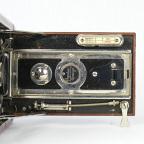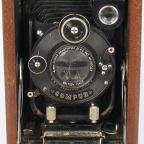Popular Ensign
Houghton-Butcher Manufacturing Co Ltd.
| Name: | Popular Ensign |
| Manufacturer: | Houghton-Butcher Manufacturing Co Ltd. |
| Country of Origin: | United Kingdom |
| Construction: | Folding camera of conventional upright format with a shell constructed of wood and aluminium and covered with brown leatherette. |
| Production Period: | Unknown |
| Plate / Film Size: | 2¼B rollfilm |
| Lens: | Lumar Anastigmat F=4", f4.5 |
| Shutter: | Compur |
| Movements: | None |
| Dimensions (w x h x l): | 9 x 18 x 3.5 cm (closed) |
| Date of this Example: | c1925 |
| Serial Number: | Serial 1282 stamped inside well for top spool. Serial #258646 on side of shutter. |
| Availability: |
|
| Inventory Number: | 608 |
|
Photos copyright © 2013 David Purcell. Do not use without permission. |
Description
The Popular Ensign is an unusual variant, with a wooden body covered in brown leatherette finish. The bellows are the conventional black, chamfered style. It has a matching brown leather strap with Ensign embossed in the centre.
It is equipped with a Compur compound shutter (speeds to 1/250) and a Lumar Anastigmat lens. McKeown lists this camera, albeit as a Popular Ensign Sports model (no "Sports" designation visible on this camera) but with an f/6.3 Lumar lens with a Trichro shutter, while this camera has a faster f4.5 Lumar lens as well as the better quality shutter. In all other respects it looks the same as that listed in [1], but presumably this is therefore a more expensive model. The model name is identified on a circular plate on the baseboard. The lens standard is a metal U-frame, but has no fitted movements.
The inside of the aluminium back carries a standard label for Ensign 2¼B films. A roundel on the side of the camera repeats the Ensign name and states "British Made" (repeated on the film label and lens).
The camera is supplied with a metal sheathed shutter release cable, which is held in a fitting on the baseboard when not in use. It has a conventional reflecting finder. A short support stand is also located on the baseboard to allow the camera to stand in a horizontal format. It has two tripod bushes, one in the baseboard (portrait) and one in the side of the body (landscape).
Notes
The release catches on the back are identical on each side but are not central, thus preventing the back being put on upside down. Different makers use different methods to prevent the back being inserted incorrectly. Kodak commonly used asymmetric catches on cameras such as the No 3A Folding Pocket Kodaks (an enhancement to the design introduced during the long life of the camera).
![[ ]](../../images/unchecked.png)
![[x]](../../images/checked.png)








